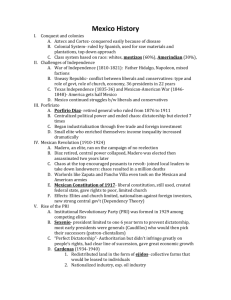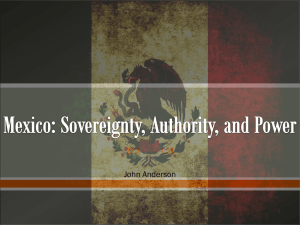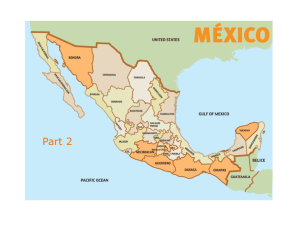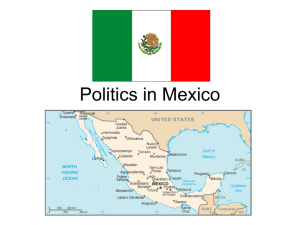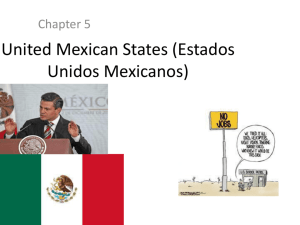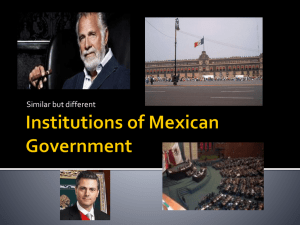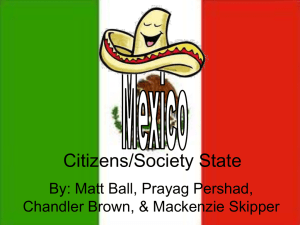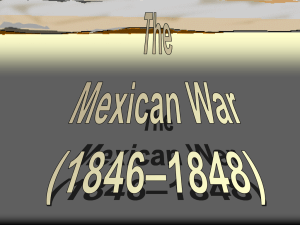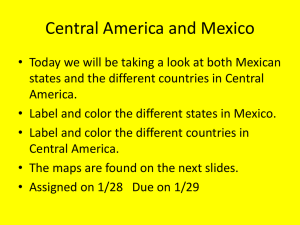Political Participation in Mexico
advertisement
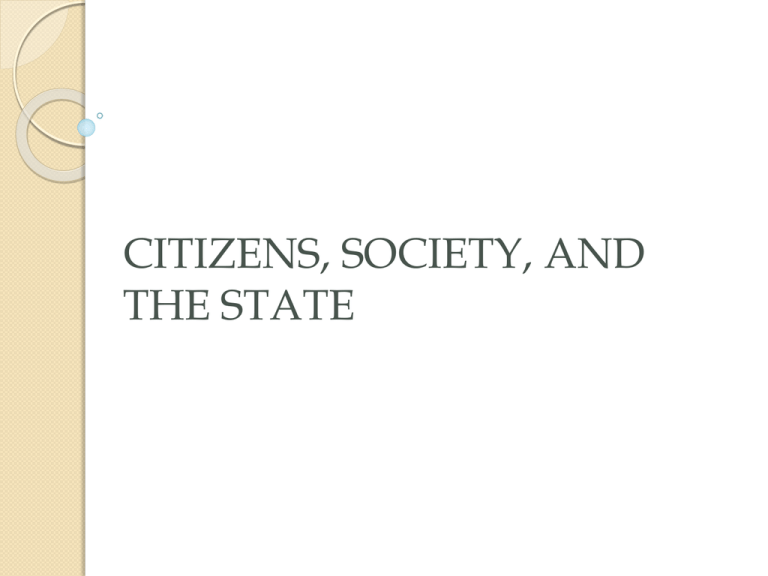
CITIZENS, SOCIETY, AND THE STATE CITIZENS, SOCIETY, AND THE STATE: BACKGROUND • Mexican citizens have interacted with their government through an informal patron-client relationship • Government has upper hand in determining which interests to respond to and which interests to ignore • Recently, political parties have become more competitive and democratic Cleavages Cleavages of Mexico are often crosscutting, but have recently coincided as the north and south have been at odds. Cleavages with the most direct impact on political system are: ◦ ◦ ◦ ◦ Social class Urban v. rural Mestizo v. Amerindian North v. South RURAL: EARLY 20th Century PRI and the patron-client system controlled largely illiterate peasants in exchange for support URBAN: PRESENT DAY Today’s Mexico is more than 75% urban Literacy rate is about 90% Voters are less inclined to support the PRI Often receptive to political and economic reform Urban v. Rural Urban v. Rural Cleavage MESTIZO A blend of European and Amerindian descent Possess most of Mexico’s wealth AMERINDIAN More likely to live in poverty in marginalized rural areas As many as 30% of Mexicans consider themselves Amerindian MESTIZO V. AMERINDIAN NORTH Very dry and mountainous Population is more prosperous Substantial middle class with relatively high levels of education Generally more supportive of a market-based economy SOUTH Largely subtropical Generally less influenced by urban areas and the U.S. Larger amount of population is Amerindian Lower average income than in the North Less educational opportunities and skilled labor Distrustful of central government NORTH V. SOUTH SOCIAL CLASS Gini coefficient was .48 in 2009 (economic inequality is high) In 2002: ◦ The poorest 10% of the population earned about 1.6% of Mexico’s income ◦ The wealthiest 10% earned 35.6% of Mexico's income ◦ This economic divide translates into higher infant mortality rates, lower levels of education, and shorter life expectancies among the poor Mexico’s middle class has been growing due to the “informal economy” and from new industries and service businesses Political Participation in Mexico History of Political Participation Mexico’s culture of political participation has been characterized by revolution and protest since the Revolution of 1910-1911 However, most Mexicans have been subject to authoritarian rule by an elite class, especially under the PRI (Partido Revolucionario Institucional) The PRI dominated Mexican politics for most of the 20th century (beginning in 1929) History of Political Participation Revolution and Protest: ◦ Revolution of 1910-1911 ◦ Caudillos (Warlords): Formation of PRI under President Calles in 1929 ◦ 1968 Student Protest in Tlatelolco Plaza ◦ 1994 Zapatista Uprising ◦ 2006 Oaxaca Protest History of Political Participation Left: a 1968 student propaganda poster Above: Subcomandante Marcos, leader of the Zapatista Rebellion The Patron-Client System Political system emphasizes compromise among elites Behind-the-scenes conflict resolution encouraged Distribution of rewards to contacts and supporters Rooted in the PRI’s camarilla system, which granted peasants and supporters job and security benefits in exchange for votes The Patron-Client System Still a determining factor in political participation today, especially in regional elections 2006 Presidential Election: losing candidate Andres Manuel Lopez Obrador accused the PAN party of election fraud based in the camarilla system Voter Behavior Before the 1990s, the PRI controlled elections on the local, state, and national levels However, competing parties have existed since the 1930s Voter turnout was high in the 1994 (78% turnout), but has since declined (60% turnout in 2006) Voter Behavior Some factors that influenced voter behavior in the election of 2006 were: ◦ Region (North v. South) ◦ Education (university education v. uneducated poor) ◦ Income Civil Society in Mexico Linkage Institutions-Political Parties PAN ◦ Party to the right of PRI ◦ PRI’s oldest opposition party ◦ Advocates less government intervention ◦ Appeals to middle class, northerners, and the educated. PRI ◦ Ruled as a one party system ◦ Corporatist structure ◦ Patron-client system ◦ Appeals to rural people, and residents of southern Mexico PRD ◦ Party left of the PRI ◦ Appeals to the young, populists, and some intellectuals Media The media had little power to criticize or to influence opinion because of the PRI Media became more independent in the 1980s as he PRI began to lose is hold Today there are many more international news sources such as CNN and BBC Mexicans now have access to a much broader range of political opinions Interest Groups The Mexican government responds to demands of interest groups through accommodation and co-optation Because private organizations have been linked to the government for so long, development of Mexico's civil society has been slow In rural areas, peasant organizations are encouraged through he ejido system which grants land to these organizations from the government Since 1980 these groups have demanded greater independence from the government In recent years they have come together to promote better education, health services, and environmental protections As these groups have strengthened, the political system has had to negotiate with them, transforming civil society Women’s Role in Mexico In the early 20th century, women had few political rights 1922: region of Yucatan gives women political rights to vote in local and regional elections 1947: Women allowed to run for office at municipal levels 1953: Full women’s suffrage granted to all provinces Women’s Role in Mexico Women have traditionally been responsible for household maintenance and child rearing Women were important in the Mexican revolutions of the early 1900s Lost much of their political influence under President Porfirio Diaz Women and children have been traditional targets of human trafficking since the early 20th century Women played a significant role in the Mexican Student Movement of 1968, protesting for income and opportunity equality Women’s Role in Mexico Today, women are an important force in Mexican politics: parties are bound by law to run at least 30% women for the proportional representation elections However, no major party has yet fielded a female presidential candidate, although the minor party Social Democrats and Farmers ran Patricia Mercado in 2006 MARIA ANTONIETA PEREZ REYES A representative of the province of Juarez in the Mexican Congress.
